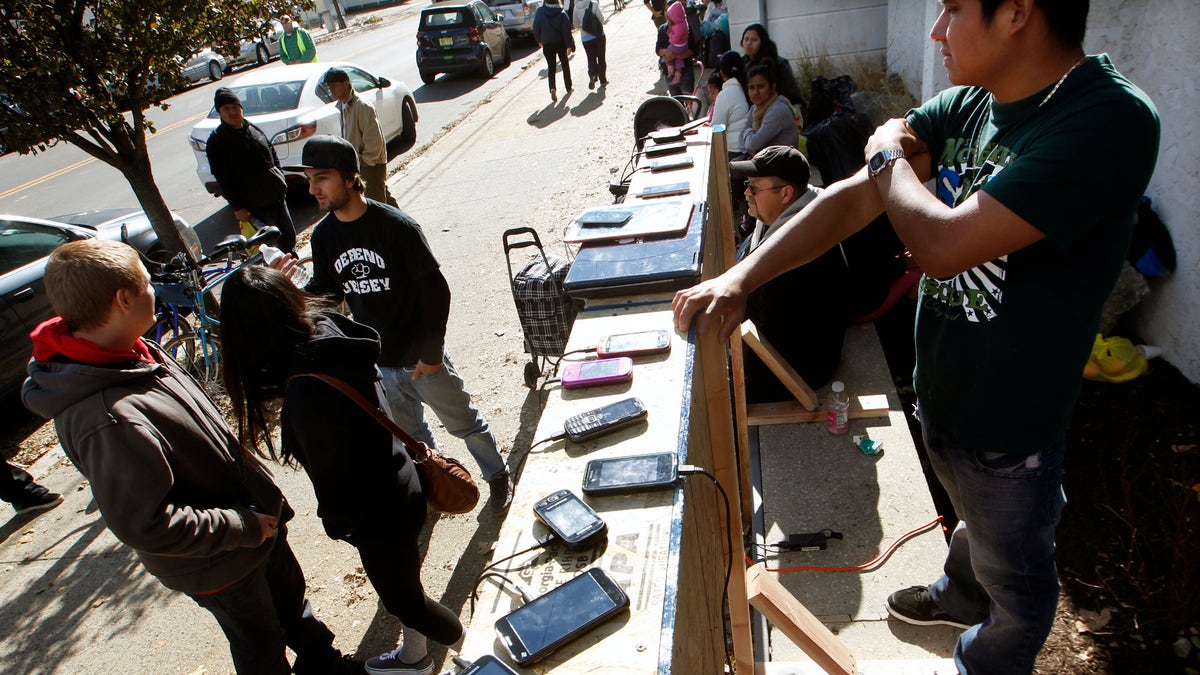
FILE - In this Nov. 4, 2012, file photo, people charge their mobile device at a free cell phone charging station outside the Belmar recreation center in Belmar, N.J., as much of the area remains without power from the storm surge by Superstorm Sandy. The experience of people who lived through Superstorm Sandy suggests that people stayed in touch with one another using a blend of new and old modes of communication in the hardest-hit parts of New York and New Jersey. But there was greater cooperation among neighbors who used old-style, face-to-face interaction. (AP Photo/Mel Evans, file) (The Associated Press)
How do you connect to the world if you're in the middle of a disaster?
The experience of people who lived through Superstorm Sandy suggests that people stayed in touch with one another using a blend of new and old modes of communication in the hardest-hit parts of New York and New Jersey. But there was greater cooperation among neighbors who used old-style, face-to-face interaction.
About three-quarters living in the affected region reported using cellphones (77 percent) or in-person conversations (73 percent) to keep in touch through the storm, according to a survey of 16 affected counties conducted by the Associated Press-NORC Center for Public Affairs Research. Fewer turned to landline phones, email, Facebook or Twitter.
A new analysis of the survey data, collected between April and June of this year, shows that those who relied on in-person communications were more apt than those using other means such as by phone or social media to report positive social interactions in their neighborhoods and to seek out help. Majorities of those who had face-to-face interactions said people in their neighborhoods were sharing food or water, sharing generators or access to power, taking in neighbors whose homes were damaged and collaborating to repair homes afterwards. Fewer than 4 in 10 who lived through the storm without relying on face-to-face communications experienced the same kind of cooperation.
Those who spent time talking with neighbors during the storm noticed: 81 percent said they felt the storm brought out the best in their neighbors, compared with 67 percent among those who did not have face-to-face interactions with neighbors. This kind of community collaboration is often connected to resilience, a concept researchers are exploring to determine why some communities rebound more quickly than others after disasters.
Social media became a focal point for news and first-person descriptions of the storm's impact a year ago, yet only 7 percent in the survey said they used Twitter to communicate through the storm and 31 percent reported using Facebook. Many reported trouble with cellphone service, including 72 percent of those who said their neighborhoods were extremely or very affected by the storm.
Landline telephones can be useful in a disaster, since telephone lines often work even when electricity is out, yet fewer than half in the affected areas used them to communicate after Sandy. In fact, people who said they were more impacted by the storm were least likely to use landlines to communicate, and most apt to turn to face-to-face interactions.
The AP-NORC Center survey was conducted April 9 through June 2, 2013, with funding from the Rockefeller Foundation. The poll involved landline or cellphone interviews with 2,025 adults across the country, including 1,007 who resided in one of 16 hard-hit counties in New York and New Jersey at the time of the storm. For residents of affected areas, it has a margin of sampling error of plus or minus 4.7 percentage points.
___
Online:
AP-NORC Center: http://www.apnorc.org/projects/Pages/resilience-in-the-wake-of-superstorm-sandy.aspx
___
Follow Jennifer Agiesta on Twitter: http://www.twitter.com/JennAgiesta

